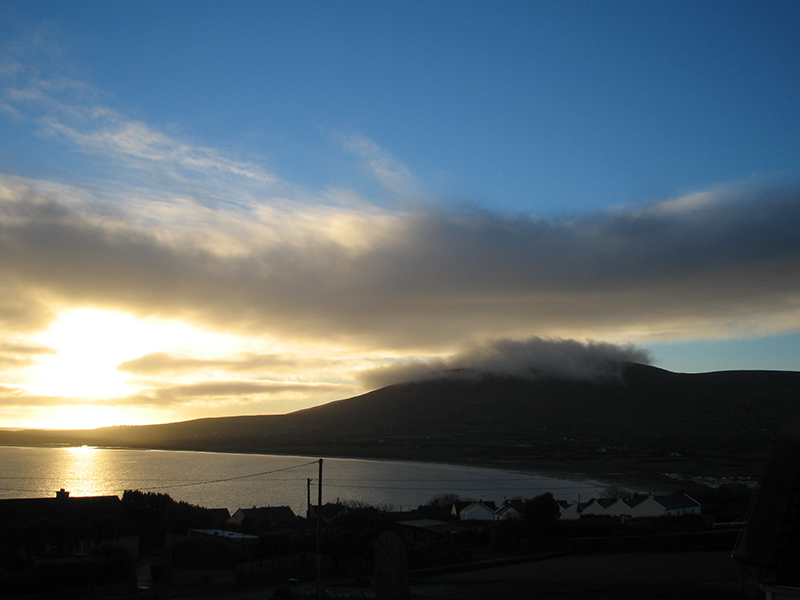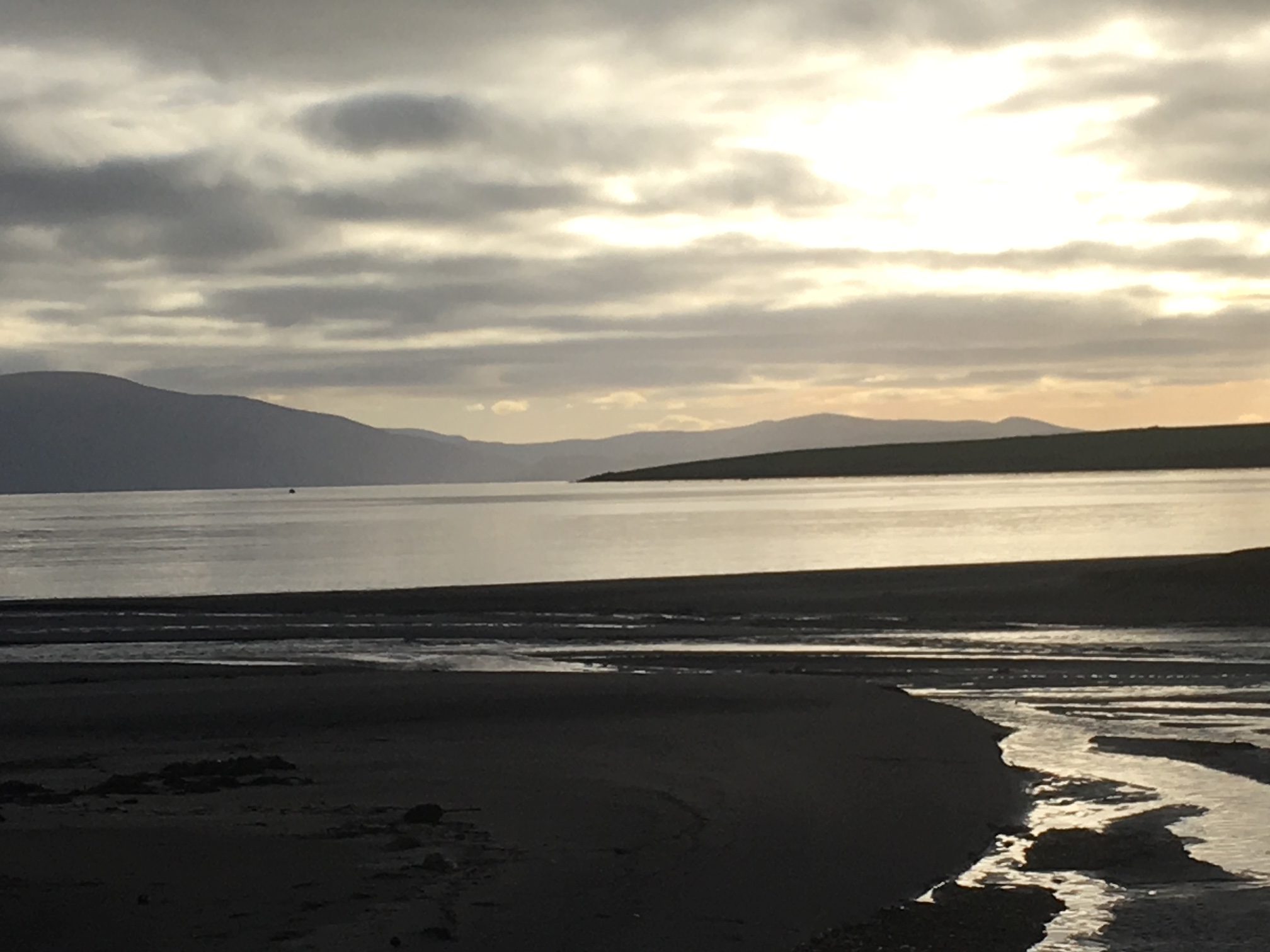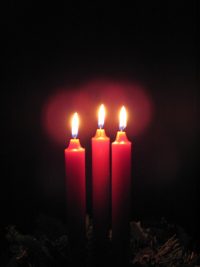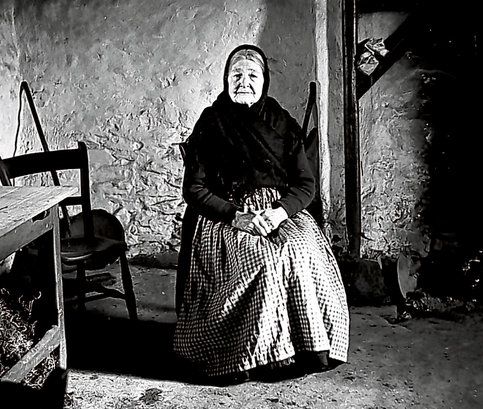
The small village of Ventry ( Ceann Trá in the Irish language) nestles close to Mount Eagle at the top of a long sandy beach and overlooking the harbour of the same name. The village is located on the southern coastline of the Dingle Peninsula which stretches out into the wild Atlantic ocean on the south west coast of Ireland.
Ventry was the location of my father’s childhood home and it was where we all relocated during holiday and vacation periods from our County Carlow home in the south east of Ireland. The house was a relatively large structure located on the western side of the village. It was a police barracks from 1850 to 1909 and was most likely built in the 1820s as a coastguard house. It was an imposing structure with large windows, a front porch and fronted at the roadside by a low wall with a wooden fence on top.
This old house was full of history and we all knew which room had been the barracks cell and which had been the public office. Upstairs, one of the bedrooms was known as the men’s room where the policemen, other than the sergeant and his wife, slept.
I want to tell you about my earliest memories of the village of Ventry and the wonderful people who lived there and who have long since passed to their eternal reward. I am taking you back to a time before electricity and the electric light arrived in early 1961 to a small village where little had changed from the start of the twentieth century. I was a six year old boy at that time.
My memories are therefore largely related to living in that village before the transformational impact of electricity.The village houses were dimly lit with kerosene lamps and candles and a small few houses had gas lamps. This all made for a rather eerie childhood experience where shadows and darkness prevailed, especially during long winter evenings.
While there was some lighting in the houses there was no lighting outside on the street. Nothing had changed for decades and nothing would change until electricity brought a new era to the village and the surrounding areas. I feel privileged to have lived in this tiny village for some weeks of the year and to have both witnessed and experienced a way of life now long since gone.I want to share these memories with you.
At that time, in the late 1950s and very early 1960s, Ventry village was a small community of about forty people .It was a close-knit community which served as a hub for the surrounding small farms. The local area was rich in archeological sites and celtic traditions. There was a rich oral tradition in both the Irish and English languages. Story-telling, singing and music were the main forms of entertainment, apart from Gaelic football.
After the labours of the day the a number of the men of the village gathered each evening in the house of the shoemaker or cobbler, Jerry Slattery. Here they discussed the stories of the day and shared any news from home or abroad where most young people had emigrated.
Women of the village gathered each night in the home of the dressmaker, Maggie Knightly to share their stories, news or personal experiences. This was how they they kept in touch with each other and assisted each other as only a caring community can do. Troubles were shared and solved.
At that time there were also other trades people in the village , mostly advanced in years. I remember the tailor , the blacksmith, the cooper, the pensions officer, the school teacher and the cab driver. Others living in this village community included a retired merchant seaman, Nicholas Brown and his sister Bella, .Other families were Currans , Sugrues and Hicks.
The village also had one pub run by Morgan Flaherty and his sister Joanne. There were two shops . Tim Kavanagh had one and the other was Long’s which was also a post office. At the top of the village stood a small primary school; to the east of the village stood the protestant church and the Catholic church was located one mile west of the village.

Ventry was surrounded by small farms and early each morning as I lay in bed I would hear horses and carts travelling along the road outside the house on their way to the creamery further west in the parish. At that time (late 1950s to mid 1960s) I never ever recall seeing a tractor or other mechanical farm machinery. Life was unchanged for many decades and except for a trickle of tourists in the summertime it could have been said that the 20th century had made little impact on life in this remote coastal region of County Kerry.
As this was a close-knit community and as it was so safe I was allowed ramble throughout the village visiting houses where I was both known and welcomed. In Summer, the front doors of houses were usually left open so rambling in to them was no problem for me. Winter winds or chills did not stop me as a quick knock on the door allowed me entry within. In this way I got to know everyone and they knew me.
To my young eyes Ventry then was both magical and mysterious.I now feel so privileged to have lived my holiday periods in such a caring and kind community. To this day, I have many wonderful memories of the people of the village-their customs, traditions and their musical Irish language (they were bilingual). Ní bheidh a leithéid arís ann – there will not be their like again.
For a very young boy, as I was then, living in my father’s birth home over the Christmas period generated mixed feelings. There were warm fires and festive fare but there was also the challenge of living with candlelight or dim gaslight ( in living room and kitchen only).

To venture upstairs at night with only a flickering candle to show me the way, required some bravery. Our mother put us to bed individually as we only felt safe in that scary environment when tucked up in bed. She always left our doors open and a candle lit outside the bedrooms so that we had some faint, flickering light other than total darkness. Both my parents were then downstairs in the living room but we made sure all doors were open in case of an emergency shout to them before we drifted off to sleep.
Left alone in my bedroom I watched the flickering shadows on the wall caused by the flickering candle outside the door. Sometimes I could imagine all kinds of monsters or ghouls in the shadows and I was sometimes alarmed by the sound of footsteps on the darkened street outside.A loud call to my mother or father downstairs usually reassured me and I would fall asleep.
My lively imagination was also fed by the ghost stories my own mother told us along with other stories from her childhood in the 1920s and 1930s. We begged her to tell us those stories as we were both excited and frightened. In my bed at night I often regretted those requests.
Christmas in Ventry was magical. On Christmas Eve every household placed lighted candles in each and every window . Now it was light which dominated the landscape as the village and surrounding area looked like a city as curtains were left open to reveal the welcoming candles in all the windows.This was also the case for Christmas Day and the following St Stephen’s Day. Preparations for this would involve placing candles in glass jars filled with sea sand. Waiting for dusk heightened our excitement as it was important to light the candles when the first few houses lit up. Timing was everything!
On these days there was little fear of enveloping darkness because there was now an candle in each of the two windows of my bedroom. But I had another fear on Christmas night that I would not fall asleep before Santa Claus arrived with presents. If he found me still awake I would not get presents. I always managed to fall asleep in time !
Waking the next morning just after dawn I would head down to the living room along with my parents, brothers and sister to find all kinds of wonderful toys . As Santa was very practical he also left educational gifts as well as some fruit.
That day was spent with the other children from the village visiting each other’s houses to see and play with toys and gifts which we usually shared.
The following St Stephen’s Day was also very exciting as in that region it was also known as The Wren’s Day (Lá an Dreoilín in Irish). People from the villages and parishes in the region would dress up in masks, straw suits or other clothing and go from house to house playing music and gathering donations for the wren ( Tradition was that a wren was caught and placed on a stick) . The origin of this tradition goes back to Celtic mythology.
Christmas was also a time when I would have some additional money which had to be spent in the local shop. I vividly remember one such occasion when I just had to visit the shop at the top of the village and do so after darkness had fallen. This required great depths of courage and was done without my parents knowledge and permission. It had to be a fast and quiet affair so that my absence from the house would not be noticed.
Though I was very young I was determined to achieve my objective to buy sweets. I ventured outside to the dark, empty street where the only noise was the sound of the waves crashing on the beach below the village. The wind swept in from the wild Atlantic causing the branches of the trees and bushes to sway. There was a moon but when it disappeared behind a large cloud the darkness fully enveloped me. I knew I was on my own ready to face whatever lurked in the dark shadows.
I passed some houses and I could see the dim light of lamps or candles behind drawn curtains. While it was only a two minute walk it seemed to be much longer because of the darkness. Did I see a person walking across the village green or was it my imagination ? Would I meet some ghouls or ghosts that my mother mentioned in her stories ? Finally, with my heart beating in my chest I arrived at the shop door and lifted the latch to gain entry.
Inside in the relative security of the shop I could smell the oil lamp which was hanging from the ceiling to provide light around the small shop. I secured my purchase and then headed back out to the darkness. As it was a downhill journey home I wondered whether or not I should run the distance in half the time. My fear with that running might show panic and a ghoul or ghost would reckon I was easy prey. Better to say calm and appear brave !
With my heart pounding in my chest I reached the door of our house and I sneaked back in. My parents were at the fireside reading and were completely unaware of my venture to the shop under the cover of darkness. I was glad to be back home. I had survived my great adventure and it was not yet 6pm !
I resolved never again to venture out to the darkened village street where the eerie sound of the wind and roar of the crashing waves only heightened my fear.There was safety in numbers and that was inside the house with my family.
Briefly, I recall other memories. In particular, when attending church on Sundays I would sit in the gallery looking down on the people in the aisle below. I remember seeing up to thirty elderly women who still dressed with traditional dark shawls over their heads, black or blue heavy skirts to mid-calf and black leather boots or shoes .Only that my father talked in a friendly manner to some of these women I would have feared for my life if they ever caught me.

Peig Sayers
These are my memories from my earliest childhood and Christmas in the tiny village of Ventry. All those kind people who lived there have long since passed on .Their way of life with unique traditions and customs are no more. I feel both lucky and privileged to have been part of their lives and culture.
At this time of Christmas I wanted to share my memories with whoever reads this from whatever part of the world. I pass on the joy of Christmas to you; Nollaig shona daoibh go léir- A happy Christmas to you all.
May peace and plenty be the first to lift the latch on your door, and may happiness be guided to your home by the candle of Christmas. May the good saints protect you and bless you today ( Old Irish blessing).
End.

